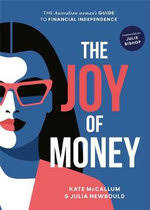Book Review – The Joy of Money by Kate McCallum and Julia Newbound

I was a little sceptical when I first picked up this book and on the front cover it says “The Australian Woman’s Guide to Financial Independence” – I guess maybe (as a male) I was not their target audience? But more so, I was worried that maybe it would not be too relevant, although, I couldn’t really imagine how gaining financial independence would be too different whatever gender you were.
The main purpose of the book is to play on the pre-conceived notion that typically women in Australia are not as financially savvy as their male counterparts. Whether that notion is true or not, I do not mind, in my eyes the more people who are more financially aware can only be a good thing for society. If that means that you need to write a book that “targets” half the country only, then so be it, if that is what it takes then go for it, as long as the information gets out there.
When I first started reading this book it seemed to pretty similar to other surface level financial books. And it would just provide the same sorts of lessons that many other beginner financial books to provide. Which at the start it more or less does, and while it is useful to learn about setting budgets, increasing your savings, setting goals, minimising bad debts etc, these days when I read a financial book, I like to look for something that provides a bit more than just the standard lessons.
I was more than pleased when I found this book had a few chapters that I believe sets it apart from other books which do aim to provide typically similar information:
- Chapter 7 – Career: Your Human Capital
This is one that is seemingly continuously glossed over in a lot of financial books, and if it is talked about, it does not seem to be in enough detail. The power to increase your income should be one of the most significant focuses to generating wealth. Saving and Investing is normally the focus, when I believe it almost cheapens the importance of human capital which can have such a defining impact on your future wealth!
- Chapter 9 – Relationships and Money
Financial incompatibility is one of the biggest causes of separation in any relationship. And the implications of a relationship turning sour (especially a marriage) can have really dire financial consequences. I think this is the first book I have read that actually talks about what happens if there is a separation, and even provides a step by step guide to get all your finances in order post-separation.
This section also provided a good list of questions that could be asked early on when dating to find out if you are on the same page financially. For some reason finances are rarely discussed even between people closest in your life, you could find yourself in a serious relationship without understanding the other person’s financial position or attitudes toward their own finances. Finding out these things early on could prevent a future mistake, or at least align your individual paths early on with compromise.
- Chapter 10 – Dark Days
This is another section I do not think I have seen in a financial book before. We will all die eventually, but what actually happens in the world around us when it does happen? How do we set ourselves up to make sure our living wishes are met when we can no longer speak for ourselves? This provides a really useful starting off point on where to start looking to set ourselves up for this dark moment. I really appreciated this section being included because it was a real eye opener for me personally and a reminder than even though I am relatively young, maybe I should set up a Will – there is no harm so why not?
Overall, although I may not have been the target audience, I found the book to be a really useful all-encompassing lesson guide that covers just about every stage of life – probably from at least early adulthood onwards at least. It covered topics that I rarely see in these sorts of books which provided valuable information. Although each individual chapter may have only gone just beneath the surface on each topic, it gave really helpful starting off points to allow for a deep dive, at least providing a trigger point in your brain to let you know you need to think about it.
The final thing I really did enjoy about this book is it provided several case studies of real people. There is a good chance that one of these case studies will be in a very similar position to yourself and you can learn a lot from the advice they have provided for the person, tailored and suited right for you. Even if it may not be specific to your situation, there is typically at least something you can learn from the personalised advice.